r
rabarijacket
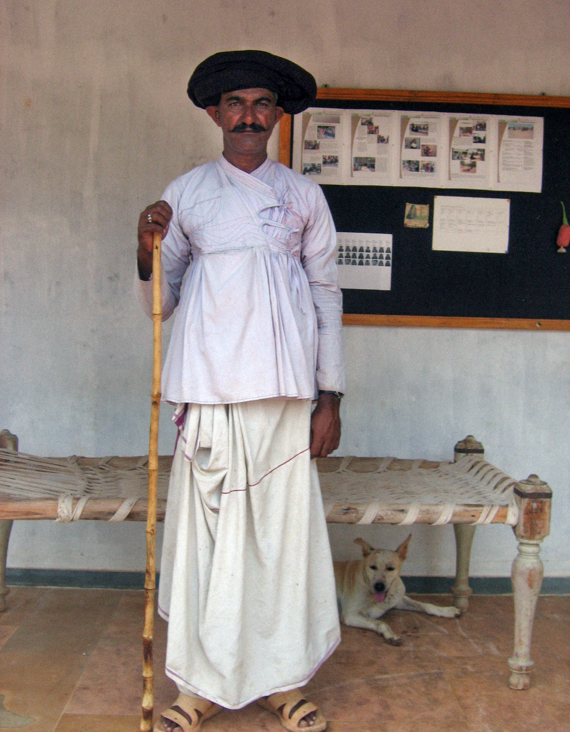
Rabari jacket (India)
A medium weight cotton wrap jacket characteristically worn by Rabaris. The Rabaris are tribal pastoralists, historically nomadic but now largely concentrated in the Kutch area of Gujarat and in Rajasthan. The traditional jacket, properly called a kediyun, consists of a fitted bodice with crossover closures, high waist with dense gathering below, and extra long sleeves intended to be worn creased along the arm. Silhouettes may vary, signifying different pastoral communities based on placement of a waistline, volume of gathering, or back yoke. Styles can range from a plain work garment to a heavily embroidered ceremonial outfit. The herders’ traditional plain cotton muslin style, which Christina first noticed on the street on a trip to Ahmedabad in 1999, is the inspiration for dosa’s Rabari jacket. The silhouette has been reiterated at least five times, each version further refined for a better fit.
recyclingatdosa
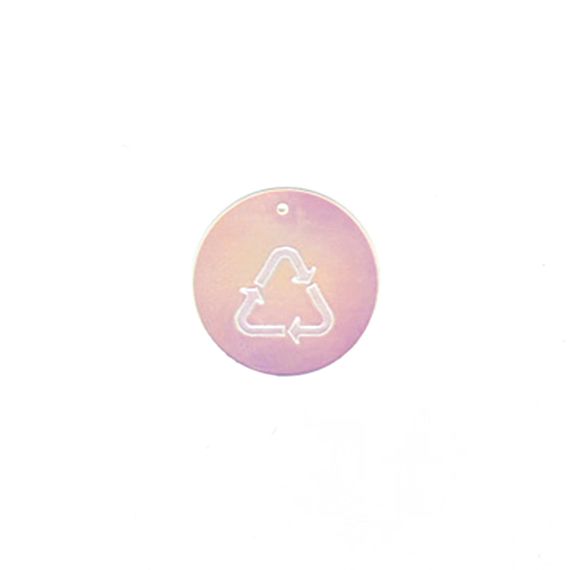
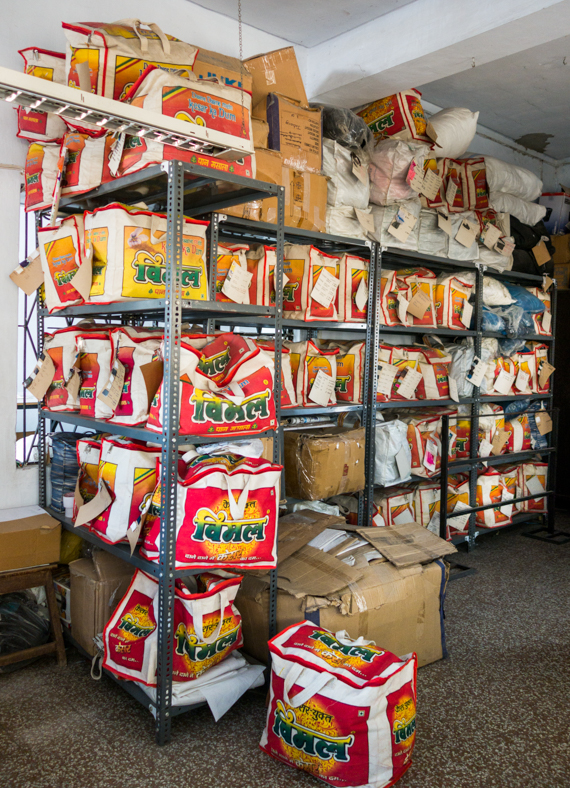
recycling
dosa’s design practice of “using less and cherishing more,” which sprung from a need to honor the skills and hours of labor embedded in a handmade traditional textile. Over 20 years have been invested in devising new ways to recycle, redesign, and re-engineer production leftovers to ensure that every last scrap of fabric is reused and nothing is relegated to waste.
Since 1994, when we started recycling, our practice has grown more sophisticated in both strategy and purpose. Initially, we started with repurposing large remnants into shopping bags in an effort to keep factory workers in session between production seasons. We then started collecting and archiving smaller scraps. These we reused as embellishments or for accessories, like leather wallets and milagros. By 2007, the informal process of saving and archiving scraps developed into a more formalized system of collecting, color and size sorting, weighing, documenting, and tracking.
Recycling has afforded us several creative freedoms. First, the ability to probe our design capabilities, from making simple bags to producing engineered running yardage used to create new garments, and again redesigning fallout scrap from these garments to create more merchandise. Because fallouts are random in shape and size, our makers are constantly being challenged to create as they work based on engineered templates.
This enables a steady and dynamic exchange between maker and designer. Second, the freedom and flexibility to produce work at any scale since everything is built from patching and piecing together small scraps. Third, the freedom from time constraints. The way we recycle would not be possible without the people who perform the many hours of manual work. Sorting, documenting, cutting, patching, and sewing all require time. More time translates to more jobs without having to consume additional natural resources. More time is viewed as a positive factor.
For dosa, recycling is a rigorous and comprehensive effort, beginning at the first stages of design and continuing through one, two, or several rounds of production. It is beneficial to our environment, beneficial to our producers, and makes good financial sense.
The end product of all this work speaks for itself: a unique item that carries the mark of the maker, an invisible quality that we believe gives dosa products their beauty.
recycledbandhani

recycled bandhani (India/Mexico/USA)
Engineered running yardage constructed by piecing together bandhani remnants and scraps, first developed in 2008. Small bandhani scraps are basted onto a khadi cotton base and finished with cutwork and appliqué. First, a freehand design mimicking the original bandhani design is outlined in pencil onto the fabric pieces. Scraps are then cut into shapes, turned under, and appliquéd with tiny hand stitches. The overall design effect was inspired by jaali, the lattice or filigree patterned windows frequently used in Islamic architecture. See also bandhani
recycledcorazónmilagro
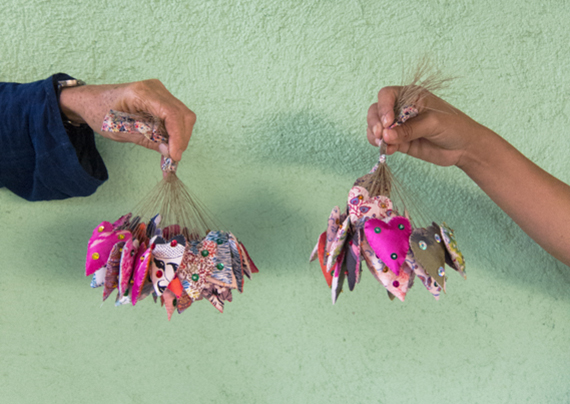
recycled corazón milagro (Mexico)
Handmade fabric heart inspired by the religious folk charms sold outside the Basilica de la Soledad in Oaxaca. dosa’s corazon milagro project started with the help of Trine Ellitsgaard as a multi-focused endeavor: to provide local women employment while also finding a creative use for the smallest fabric scraps generated from dosa’s production. Each heart is handstitched, stuffed, and beaded by a small group of women in the town of Ejutla de Crespo. Paper packaging is made by El Taller Arte Papel. Single hearts are in handmade majahua paper boxes, while garlands of hearts are wrapped around handmade majahua paper. Julia, who locally organizes and facilitates the process, was able to purchase land from the steady income created by this project. From 2006–15, 209 kg (460 lbs.) of recycled scraps were reused to make 106,500 individual corazón milagros. See also El Taller Arte Papel; recycled jamdani; Trine Ellitsgaard
recycledcottonbook
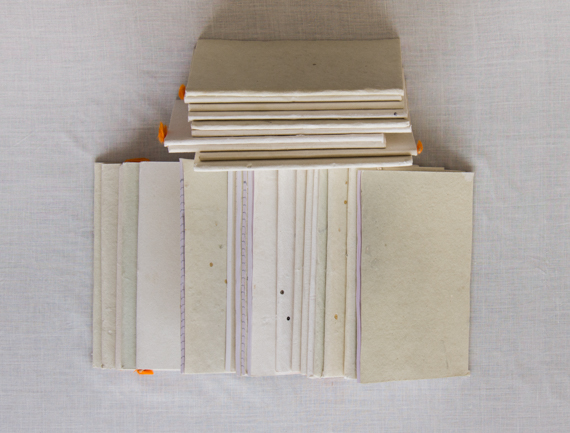
recycled cotton notebooks (India)
Notebook with a handmade paper cover embedded with shredded cotton scraps, bits of mica, and sequins leftover from dosa clothing production. The paper is made at the paper workshop of the Gandhi Ashram in Ahmedabad. They are dyed using what is locally available such as tea leaves and hibiscus flowers. Our recycled notebook project started in 1996.
recycledjamdani
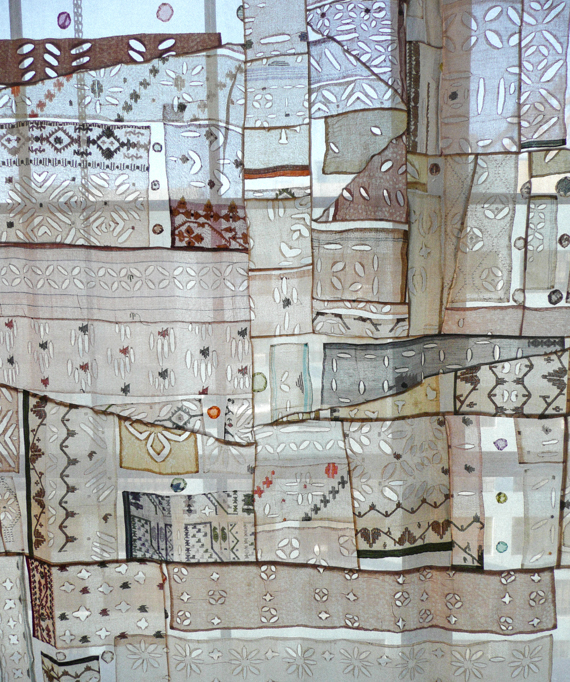
recycled jamdani (India/Mexico/USA)
Running yardage and accessories engineered from jamdani sari end-pieces and smaller, oddly shaped scraps generated from clothing production in India and Los Angeles. Rectangular end-pieces are pieced together to form a 4-meter (4.4 yds.) long base, upon which smaller jamdani scraps are appliquéd according to the artisan’s own freehand design. The first time we employed this technique, we used archived jamdani scraps collected during our 2003–08 productions. This first generation of recycled engineered yardage was used for our 2008 clothing production. Fabric leftovers from that production were again collected, saved, and repurposed for second generation recycled patchwork curtain panels. The process continues as an ongoing effort in every production season. The tiniest of scraps saved throughout the separate productions are used for tikdi appliqué, recycled corazon milagros, and recycled talismans.
Between 2003–08, dosa used 13,545 m (12,385 yds.) of handwoven jamdani yardage for its clothing production. From this, scraps were collected and repurposed into 800 m (875 yds.) of recycled running yardage, which we used to produce the Spring 2008 collection. See also jamdani; recycled corazón milagro; recycled shopping bag; recycled talisman
recycledkashmirishawl
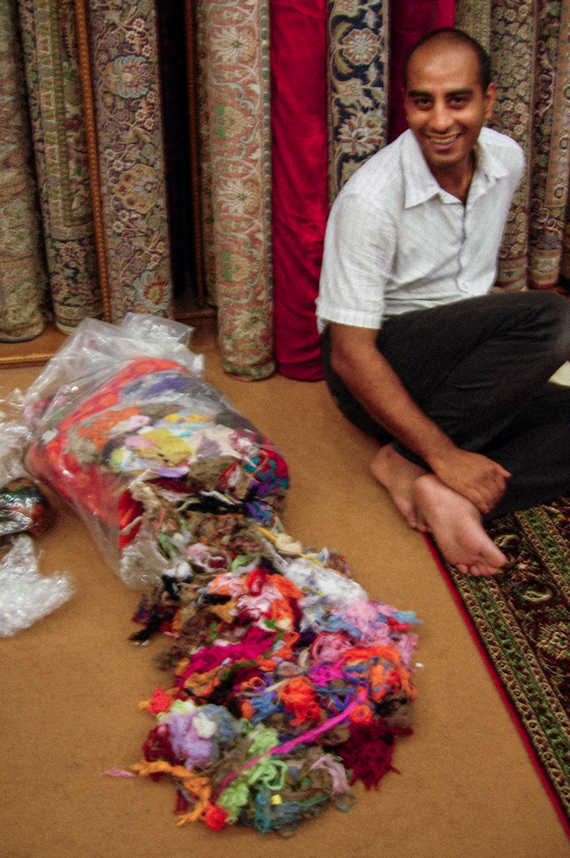
recycled Kashmiri shawl (India)
Shawl woven from pure cashmere warp and re-spun remnant cashmere weft. In standard shawl production, two to four shawls are woven continuously on one loom with 5–8 cm (2–3 in.) spaces in between. Ordinarily, this loosely woven area marked with a contrast color strip gets discarded when shawls are cut apart. Instead, we save these remnant strips, unravel the fibers, then have them re-spun and reused as weft for our recycled Kashmiri shawl. The varying colors of the re-spun fibers create a striped pattern design. Initially, stripes were woven at random, but with more experience, our weavers in India are able to engineer patterns by strategically grouping colors. This project was started in 2008.
recycledkhadipojagiscarf
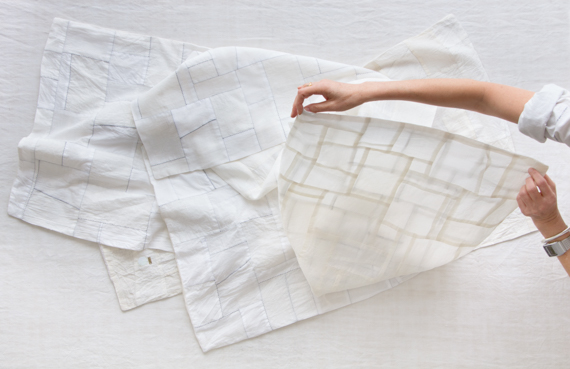
recycled khadi pojagi scarf (India)
Standard issue accessory made of khadi cotton and silk scraps from standard issue clothing production. The scarf’s design employs the principles of Korean pojagi. Scarves are one of a kind but always consistent in color: yi, indigo, midnight. See also pojagi
recycledleatherpouf

recycled leather pouf (USA)
Stuffed leather cushion, Morrocan-inspired, made from old leather stock and Polartec® fleece scraps initially generated from our 1996 winter clothing line. The number of poufs we make correlates to the number of fleece garments we produce. Approximately 35 Polartec® garments yield enough stuffing for one pouf. As soon as a sufficient weight of scraps have been saved, the process of cutting, sewing, stuffing and hand stitching begins. Sewing and stuffing one pouf takes about six hours. The poufs are made in four styles: small (8 kg/ 18 lbs.), large (13 kg/28 lbs.), round (13 kg/28 lbs.), and rectangular (19 kg/42 lbs.). This project began in 1997 and poufs are still actively being produced. As of January 2015, the wait list was at 47 people dating back to 2008. From 1997 to date, 1400 poufs have been made using 12,700 kg (28,000 lbs.) of scraps. With one half kilogram (1 lb.) roughly equal to one meter (~1 yd.) of fabric, that is an estimated $253,400 in reused fabric. See also recycled leather wallet
recycledleatherwallet
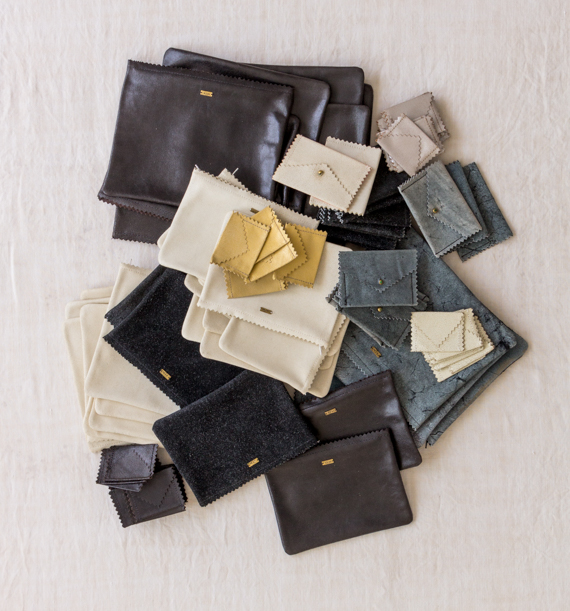
recycled leather wallet (USA)
Wallet made of repurposed leather scraps generated from housewares production. At its start in 1996, the wallet was designed to utilize scraps leftover from pouf production, but quickly became one of our signature accessory items. Wallets are produced in 4 sizes: talisman pouch, card case, small zip, and large zip. Poufs and wallets represent the very beginning of dosa’s integration of recycling with production. See also recycled leather pouf
recycledLibertycotton
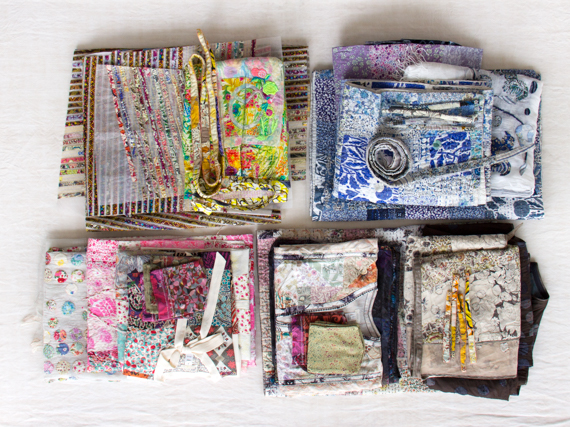
recycled Liberty cotton (India/Mexico/UK/USA)
Liberty print cotton was used in our very first collection, in 1984, and in every season since 2003. In 2007, we began saving and archiving our own Liberty scraps, amassing 28 kg (61 lbs.) in three months. This lot yielded 117 engineered wrap skirts for our Spring 2008 collection. Liberty & Co. has become a longtime supporter of our recycling initiatives, the only outside company to regularly donate old samplers and headers to us throughout the year. From 2008–15, we incorporated Liberty cotton scraps in 34 styles and produced 3,650 pieces generating a wholesale value of $360,000.
recycledshatteredglass
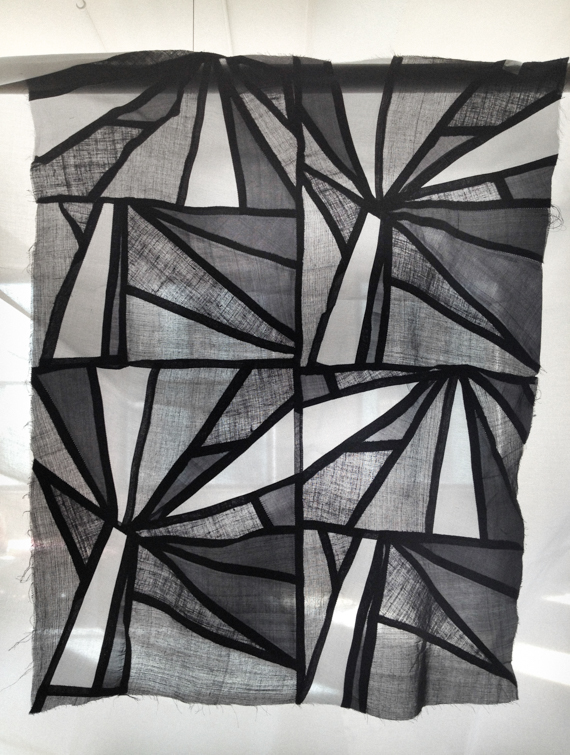
recycled shattered glass (India/USA)
Engineered patchwork yardage based on a repeat geometric pattern resembling shattered glass. The overall design pattern appears never-ending and random, but is carefully engineered and entirely reproducible for production. Small fabric scraps are cut into geometric shapes, arranged in progressive scale, then composed into a patchwork to create running lengths of yardage used for clothing production. Conceived and developed by textile artist Karen Spurgin in 2011, shattered glass was inspired by the idea of fractals. The design is a positive demonstration of the inventive and contemporary application of traditional textile techniques.
recycledshoppingbag
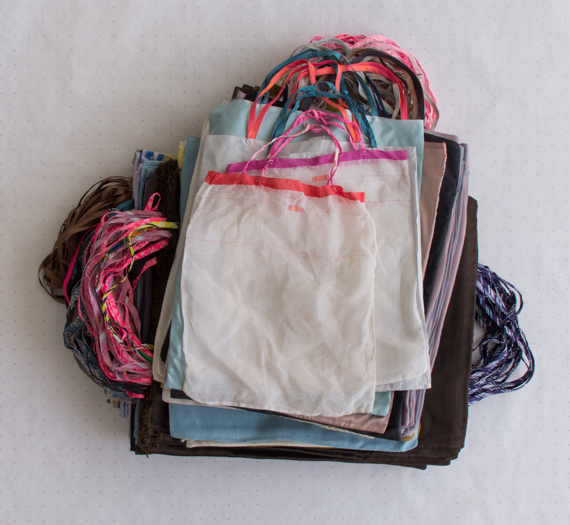
recycled shopping bag (India/USA)
Cloth bag constructed from large-sized selvedge remnants that we give away to customers in lieu of a conventional paper bag. The shopping bag was one of our first recycling projects, initiated in the mid-1990s as a way to reuse fabric scraps and also keep our Los Angeles factory workers in continuous operation between production seasons. Fabric and colorway constantly evolve to reflect the color palette of recent collections. From 2008–15, we have produced 9,955 bags.
recycledtalisman
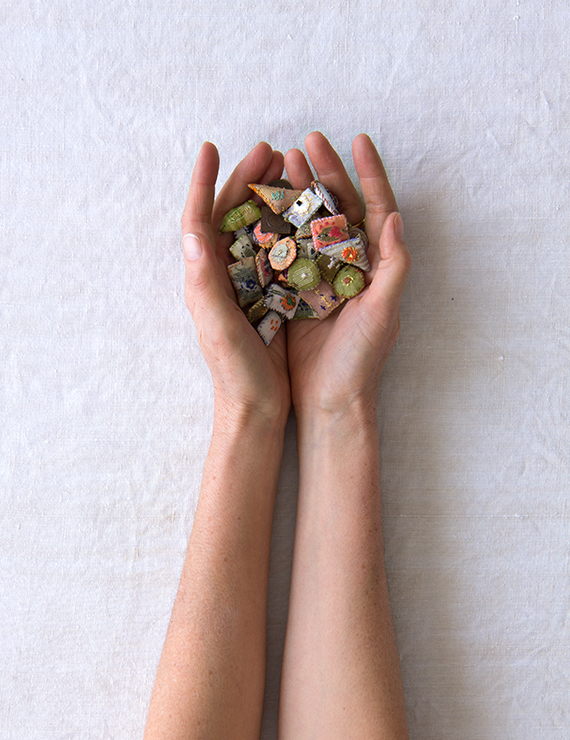
recycled talisman (India)
Charm made from tiny fabric scraps with a Hindu blessing and fragrant herbs tucked inside. Talismans are thought to bring power and good luck to the wearer. Ours are made by a group of women and a family in India overseen by Mona Shah. See also recycled jamdani
recycledvelvetnotebooks
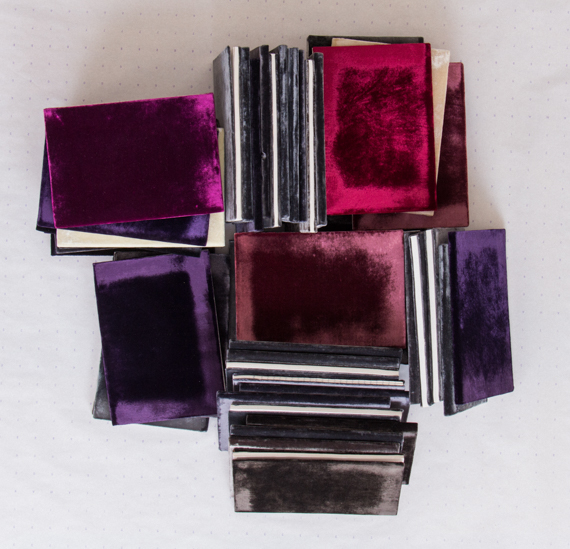
recycled velvet notebooks (India/USA)
A velvet-covered handmade paper notebook initially made for Elle Decoration UK in 1997. Paper notebooks were stitched in Jaipur, India, then brought to our Los Angeles factory and covered with silk velvet remnants from our 1995-98 clothing productions. The velvet covers were made by college student and part-time employee, Lupe Ruiz, who spent her summer helping at dosa.
rose
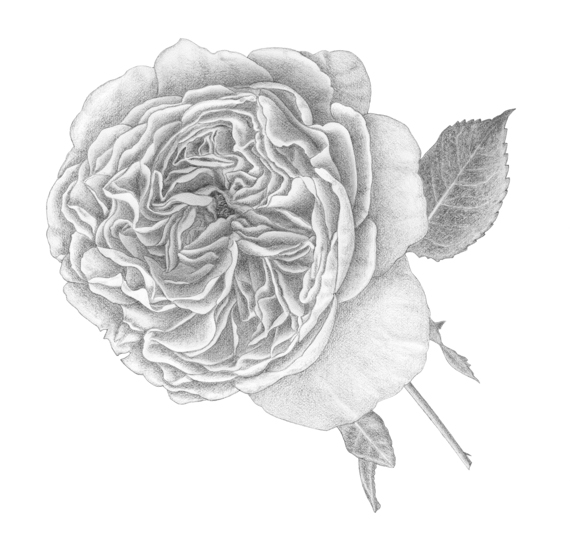
rose
Flowering plant of genus Rosa admired for its vibrant blossoms and fragrance. In India, we dye with discarded red rose blossoms collected from Hindu temples. Fresher petals give a jammy plum color, dryer petals dye brown. In Hindu worship, roses are offered to the goddess of beauty Lakshmi. According to ancient legend, when Brahma saw a rose, he was so enamored with its fragrance and beauty he created Lakshmi out of its petals. The goddess emerged from a blossoming rosebud, held in 108 large and 1008 small petals. The rose was considered the cradle of beauty, a symbol of divine mysteries. See also Adiv Temple Blessings